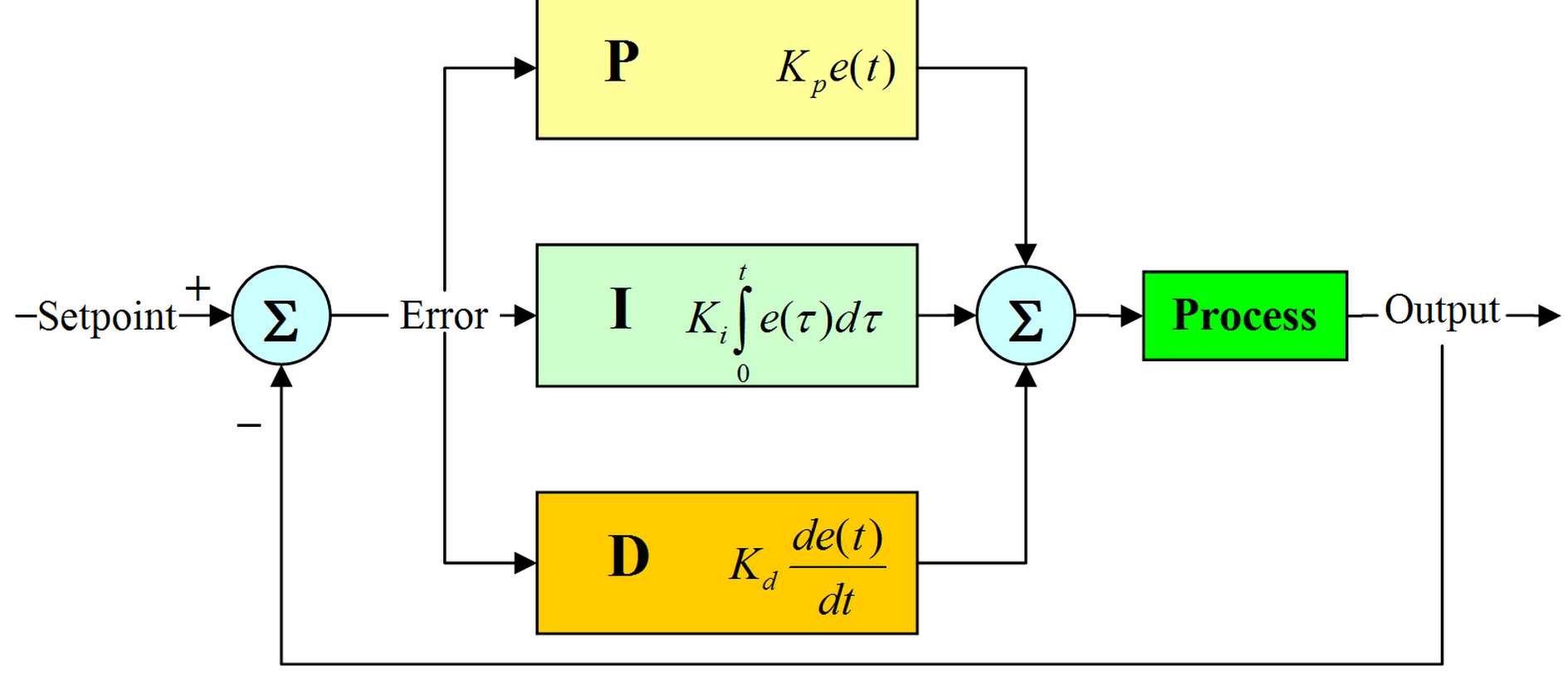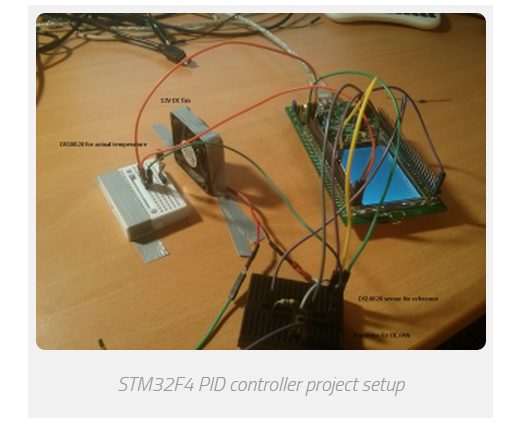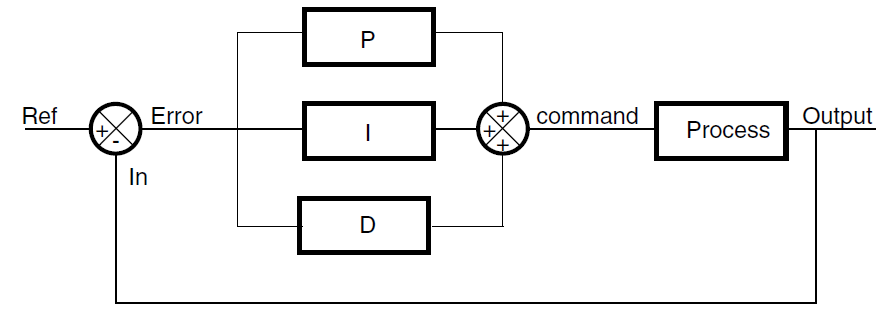Project 03- STM32F4xx PID controller
Project 03- STM32F4xx PID controller
CMSIS files from ARM provides ARM Math functions.
There are also PID controller functions in different formats for f32, q31 and q7.
This tutorial/project will talk about how to implement PID controller on STM32F4xx using PID functions from ARM.
PID Controller
Fast about PID controller.
PID stands for Proportional-Integral-Derivative controller.
This is a control loop feedback mechanism widely used in industrial control systems.
It calculates the error between measured value and the desired setpoint value.
According to the error, it then calculates output value to minimize this error.

I will not go step-by-step on how PID works. More you can look on the sites below:
ARM PID library
ARM company provides 3 different PID controller functions:
- f32: float
- q31: integer
- q7: char
For each of the three types, you have three functions:
- f32
- arm_pid_init_f32
- arm_pid_reset_f32
- arm_pid_f32
- q31
- arm_pid_init_q31
- arm_pid_reset_q31
- arm_pid_q31
- q7
- arm_pid_init_q7
- arm_pid_reset_q7
- arm_pid_q7
There are also ARM PID structure, where you pass PID parameters.
More in project example below.
If you need additional info about these functions, you have detailed manual here.
PID Sample project
In the project, 2 DS18B20 temperature sensors are used.
They are configured in 12bit resolution, so delay between 2 calculations is about ~750ms.
If you read about PID controller, you realize that you cannot calculate PID controller results every x microcontroller,
because it has integral part which is used to sum all the errors in period.
More calculations you have, more integral error you have.
We have one device connected as “reference” temperature.
Second sensor is placed near DC FAN,
so when DC fan is turned ON, it is cooling the second DS18B20.
The goal is, that both temperatures are the same.
In my case, it was about 23°C on the reference sensor.
Then, I touched the second DS18B20 near DC fan and I heated them. DC fan was turned on.
Everything is displayed via USART to computer.
FAN is controlled via 1kHz PWM output.
According to the error between both sensors, more error, more duty cycle to DC fan.
This is just a sample project, so PID parameters are not set optimal.
For every project you have to set parameters for specific project.
This example successfully works on all STM32F4xx development board such as Discovery and Nucleo.
In the example, 1 PID controller is used.
If you need to control more than just one thing,
you can add additional ARM PID instances and
you can use more than just one PID controller at a time.
Pinout
- Both DS18B20 sensors are connected to the same pin: PA6
- DC fan PWM pin (controlled via transistor): PA5
- USART output: PB6, 115200baud
Example

/**
* Keil project for DS18B20 & ARM PID example
*
* Before you start, select your target, on the right of the "Load" button
*
* @author Tilen Majerle
* @email tilen@majerle.eu
* @website http://stm32f4-discovery.com
* @ide Keil uVision 5
* @packs STM32F4xx Keil packs version 2.2.0 or greater required
* @stdperiph STM32F4xx Standard peripheral drivers version 1.4.0 or greater required
*
* Additional defines in "Options for Target" > "C/C++" > "Defines"
* - ARM_MATH_CM4
* - __FPU_PRESENT = 1
*/
/* Include core modules */
#include "stm32f4xx.h"
/* Include my libraries here */
#include "defines.h"
#include "tm_stm32f4_delay.h"
#include "tm_stm32f4_onewire.h"
#include "tm_stm32f4_ds18b20.h"
#include "tm_stm32f4_disco.h"
#include "tm_stm32f4_usart.h"
#include "tm_stm32f4_pwm.h"
#include <stdio.h> /* Include ARM math */
#include "arm_math.h" /* How many sensors we are expecting on 1wire bus? */
#define EXPECTING_SENSORS 2 #define TEMP_CURRENT temps[1] /* Temperature we actually have */
#define TEMP_WANT temps[0] /* Temperature we want to have */ /* Choose PID parameters */
#define PID_PARAM_KP 100 /* Proporcional */
#define PID_PARAM_KI 0.025 /* Integral */
#define PID_PARAM_KD 20 /* Derivative */ int main(void) {
/* Timer data for PWM */
TM_PWM_TIM_t TIM_Data;
char buf[];
uint8_t devices, i, count;
/* DS18B20 devices ID */
uint8_t device[EXPECTING_SENSORS][];
/* Temperatures from 2 sensors */
float temps[EXPECTING_SENSORS];
/* PID error */
float pid_error;
/* Duty cycle for PWM */
float duty = ;
/* ARM PID Instance, float_32 format */
arm_pid_instance_f32 PID;
/* One wire instance */
TM_OneWire_t OneWire; /* Set PID parameters */
/* Set this for your needs */
PID.Kp = PID_PARAM_KP; /* Proporcional */
PID.Ki = PID_PARAM_KI; /* Integral */
PID.Kd = PID_PARAM_KD; /* Derivative */ /* Initialize PID system, float32_t format */
arm_pid_init_f32(&PID, ); /* Initialize system */
SystemInit(); /* Initialize delay */
TM_DELAY_Init(); /* Initialize Leds */
TM_DISCO_LedInit(); /* Initialize USART1, TX: PB6, 115200 baud */
TM_USART_Init(USART1, TM_USART_PinsPack_2, ); /* Initialize TIM2, 1kHz frequency */
TM_PWM_InitTimer(TIM2, &TIM_Data, ); /* Initialize TIM2, Channel 1, PinsPack 2 = PA5 */
TM_PWM_InitChannel(&TIM_Data, TM_PWM_Channel_1, TM_PWM_PinsPack_2); /* Set default duty cycle */
TM_PWM_SetChannelPercent(&TIM_Data, TM_PWM_Channel_1, duty); /* Initialize OneWire, pin PA6 */
TM_OneWire_Init(&OneWire, GPIOA, GPIO_PIN_6); /* Checks for any device on 1-wire */
count = ;
devices = TM_OneWire_First(&OneWire);
while (devices) {
/* Get full ROM value, 8 bytes, give location of first byte where to save */
TM_OneWire_GetFullROM(&OneWire, device[count]);
/* Increase count for devices */
count++;
/* Get next device */
devices = TM_OneWire_Next(&OneWire);
} /* We need 2 devices */
if (count != ) {
TM_USART_Puts(USART1, "We expect 2 devices on 1-wire. Quiting!\n"); /* While */
while ();
} /* Go through all connected devices and set resolution to 12bits */
for (i = ; i < count; i++) {
TM_DS18B20_SetResolution(&OneWire, &device[i][], TM_DS18B20_Resolution_12bits);
} /* Start temperature conversion on all devices */
TM_DS18B20_StartAll(&OneWire); while () {
/* If all sensors are done with conversion */
/* This will happen about every 750ms, because DS18B20 needs ~750ms for conversion in 12bit resolution mode */
if (TM_DS18B20_AllDone(&OneWire)) {
/* Read temperature 1, reference temperature */
TM_DS18B20_Read(&OneWire, device[], &TEMP_WANT); /* Read temperature 2, actual temperature */
TM_DS18B20_Read(&OneWire, device[], &TEMP_CURRENT); /* Start new temperature conversion on all devices */
TM_DS18B20_StartAll(&OneWire); /* Set LEDs according to the which temperature is higher */
if (TEMP_CURRENT > TEMP_WANT) {
TM_DISCO_LedOn(LED_GREEN);
TM_DISCO_LedOff(LED_RED);
} else if (TEMP_CURRENT < TEMP_WANT) {
TM_DISCO_LedOn(LED_RED);
TM_DISCO_LedOff(LED_GREEN);
} else {
TM_DISCO_LedOff(LED_ALL);
} /* Calculate error */
pid_error = TEMP_CURRENT - TEMP_WANT; /* Calculate PID here, argument is error */
/* Output data will be returned, we will use it as duty cycle parameter */
duty = arm_pid_f32(&PID, pid_error); /* Check overflow, duty cycle in percent */
if (duty > ) {
duty = ;
} else if (duty < ) {
duty = ;
} /* Set PWM duty cycle for DC FAN to cool down sensor for "TEMP_CURRENT" */
TM_PWM_SetChannelPercent(&TIM_Data, TM_PWM_Channel_1, duty); /* Format string */
sprintf(buf, "Expected: %2.3f C\nActual: %2.3f C\nError: %2.3f C\nDuty cycle: %3.2f %%\n----\n", TEMP_WANT, TEMP_CURRENT, pid_error, duty); /* Send to USART */
TM_USART_Puts(USART1, buf);
}
}
}
2 PID controller
2.1 Description
The proportional-integral-derivative or PID controller is commonly used in the industry.
It is a feedback loop controller that manages the process command with a view to reducing the error
between the desired set point and the measured process variable.
The following block diagram shows the parallel structure of a PID controller.
This is the structure implemented in this DSP library.
Figure 1. Block diagram of PID controller

DSP library functions
The DSP library provides three PID functions:
● DoPID: a PID core loop coded in C (the error is computed outside the function)
● DoFullPID: a full PID controller coded in C (with error computing)
● PID_stm32: an optimized PID core loop written in assembly
Project 03- STM32F4xx PID controller的更多相关文章
- SpringMVC学习03(控制器Controller)
3.控制器Controller 3.1 控制器Controller 控制器复杂提供访问应用程序的行为,通常通过接口定义或注解定义两种方法实现. 控制器负责解析用户的请求并将其转换为一个模型. 在Spr ...
- 《Symfony 5全面开发》教程03、使用Controller创建第一个页面
我们使用Phpstorm打开我们的项目目录,展开项目目录文件夹. Symfony项目其实也是composer项目,如果你新拿到一个Symfony项目, 你可以在控制台中使用composer insta ...
- PID控制器(比例-积分-微分控制器)- II
Table of Contents Practical Process Control Proven Methods and Best Practices for Automatic PID Cont ...
- Be a Smart Project Manager
The key to being a smart project manager is to remember how you are going to manage your project, to ...
- 增量与位置PID
转载:http://blog.sina.com.cn/s/blog_408540af0100b17n.html http://bbs.ednchina.com/BLOG_ARTICLE_211739. ...
- MATLAB-离散系统的数字PID控制仿真
%PID Controller clear all; close all; ts=0.001; %采样时间=0.001s sys=tf(,]); %建立被控对象传递函数 dsys=c2d(sys,t ...
- PID算法(c 语言)(转)
PID算法(c 语言)(来自老外) #include <stdio.h> #include<math.h> //定义PID 的结构体 struct _pid { int pv; ...
- PID算法(c 语言)(来自老外)
#include <stdio.h> #include<math.h> //定义PID 的结构体 struct _pid { int pv; // integer that c ...
- PID控制器(比例-积分-微分控制器)- IV
调节/测量放大电路电路图:PID控制电路图 如图是PlD控制电路,即比例(P).积分(I).微分(D)控制电路. A1构成的比例电路与环路增益有关,调节RP1,可使反相器的增益在0·5一∞范围内变化; ...
随机推荐
- oracle用户密码过期!the password has expired
Oracle提示错误消息ORA-28001: the password has expired,是由于Oracle11G的新特性所致, Oracle11G创建用户时缺省密码过期限制是180天(即6个月 ...
- WEB开发常用软件集合
软件 dreamweaver cs6 http://www.cr173.com/soft/74348.html navicat http://pan.baidu.com/s/1b9nNzw subli ...
- 环形缓冲区-模仿linux kfifo【转】
转自:https://blog.csdn.net/vertor11/article/details/53741681 struct kfifo{ uint8_t *buffer; uint32_t i ...
- Linux内核中进程上下文、中断上下文、原子上下文、用户上下文的理解【转】
转自:http://blog.csdn.net/laoliu_lcl/article/details/39972459 进程上下文和中断上下文是操作系统中很重要的两个概念,这两个概念在操作系统课程中不 ...
- 利用 devcon.exe实现自动安装驱动(转)
http://blog.csdn.net/u012814201/article/details/44919125 工作的原因打算通过devcon.exe实现自动打包的功能,由于之前一直在Linux那个 ...
- springcloud使用Hystrix实现微服务的容错处理
使用Hystrix实现微服务的容错处理 容错机制 如果服务提供者相应非常缓慢,那么消费者对提供者的请求就会被强制等待,知道提供者相应超时.在高负载场景下,如果不作任何处理,此类问题可能会导致服务消费者 ...
- H5页面关于android软键盘弹出顶起底部元素的解决方案
应用场景:用div在移动端页面设置一个底部工具栏,css的代码大概如下: .tool{ width: 100%; height: 60px; position: fixed; left: 0px; b ...
- 如何使用windows的计划任务?计划任务?
我们经常有一些程序想要过了几小时来运行:比如定时关机 或者说希望能够每天的几点执行一个什么程序: 这些所有的操作都需要用到windows的任务计划:或者叫计划任务:反正都一样 下面小编将指导大家创建一 ...
- mysql 某字段插入随机数
UPDATE `表名` SET `字段名`=ceiling(rand()*500000+500000) WHERE (条件); 写入11位手机 UPDATE xm_user a SET a.user_ ...
- Angular快速学习笔记(3) -- 组件与模板
1. 显示数据 在 Angular 中最典型的数据显示方式,就是把 HTML 模板中的控件绑定到 Angular 组件的属性. 使用插值表达式显示组件属性 要显示组件的属性,最简单的方式就是通过插值表 ...
